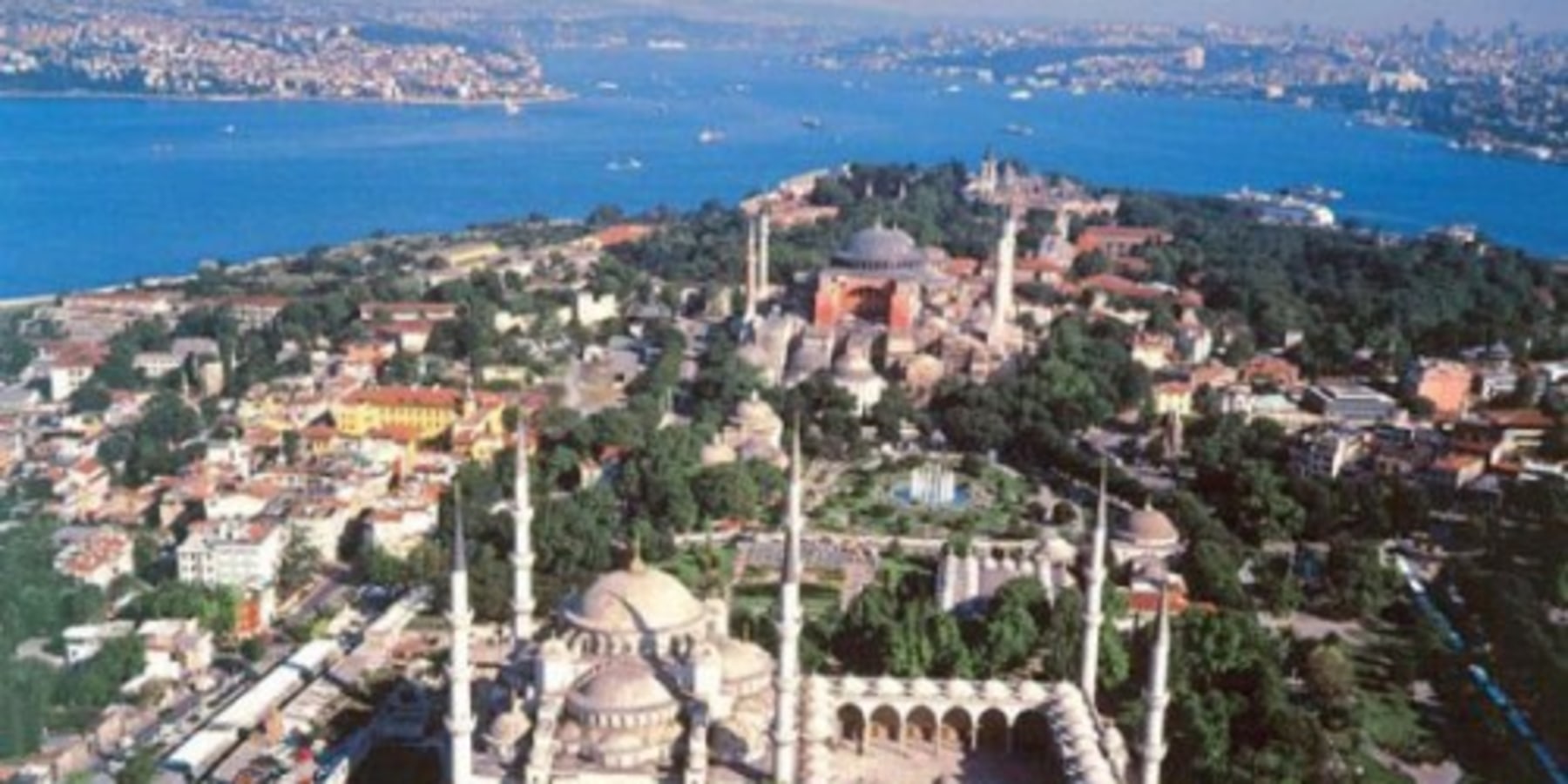
Istanbul is a huge city with several district articles containing sightseeing, restaurant, nightlife and accommodation listings — have a look at each of them.
Istanbul (Turkish: İstanbul) is Turkey's most populous city as well as its cultural and financial hub. Located on both sides of the Bosphorus, the narrow strait between the Black Sea and the Marmara Sea, Istanbul bridges Asia andEurope both physically and culturally. Istanbul's population is estimated to be between 12 and 19 million people, making it also one of the largest cities in Europe and the world.
Sultan Ahmet Mosque at dusk
Expanding the ancient Greek colony of Byzantium by the order of the Roman Emperor Constantine the Great, the imperial city of Constantinople was for nearly a thousand years the last remaining outpost of the Roman (later termed Eastern Roman or Byzantine) Empire. It was finally conquered by the Ottoman Sultan Mehmed II on 29 May 1453, an event sometimes used to mark the end of the Middle Ages. It was the nerve centre for military campaigns that were to enlarge the Ottoman Empire dramatically. By the mid 1500s, Istanbul, with a population of almost half a million, was a major cultural, political, and commercial centre. Ottoman rule continued until it was defeated in WWI and Istanbul was occupied by the allies. When the Republic of Turkey was born in 1923 after the War of Independence, Kemal Atatürk moved its capital to the city of Ankara. However, Istanbul has continued to expand dramatically; today its population is approximately 14 million and increases at an estimated 400,000 immigrants per year. Industry has expanded even as tourism has grown.
Orientation
Istanbul is divided in three by the north-south Bosphorus Strait (Istanbul Bogazi), the dividing line between Europe and Asia, the estuary of the Golden Horn (Haliç) bisecting the western part and the Sea of Marmara(Marmara Denizi) forming a boundary to the south. Most sights are concentrated in the old city on the peninsula of Sultanahmet, to the west of the Bosphorus between the Horn and the Sea. Across the Horn to the north are Galata, Beyoğlu and Taksim, the heart of modern Istanbul, while Kadıköy is the major district on the comparatively less-visited Anatolian side of the city. The Black Sea forms the northern boundary of Istanbul.
Climate
It can be cloudy, rainy, or even snowy in Istanbul
Istanbul has a temperate oceanic climate which is influenced by a continental climate, with hot and humid summers and cold, wet and occasionally snowy winters.
Istanbul has a high annual average rainfall of 844mm (which is more than that of London, Dublin or Brussels, whose negative reputation Istanbul does not suffer), with late autumn and winter being the wettest, and late spring and summer being the driest. Although late spring and summer are relatively dry when compared to the other seasons, rainfall is significant during these seasons, and there is no dry season as a result.
If there is a negative reputation that Istanbul does suffer from, it is the high annual relative humidity, especially during winter and summer with the accompanying wind chill and concrete-island effect during each respective season.
Summer is generally hot with averages around 27ºC during the day and 18ºC at night. High relative humidity levels and the ‘concrete-island effect’ only make things worse. Expect temperatures of up to 35° C for the hottest days of the year. Summer is also the driest season, but it does infrequently rain. Showers tend to last for 15-30 minutes with the sun usually reappearing again on the same day. Flash floods are a common occurrence after heavy rainfalls (especially during summer), due to the city's hilly topography and inadequate sewage systems.
Winter is cold and wet, averaging 2ºC at night and 7ºC during the day. Although rarely below freezing during the day, high relative humidity levels and the wind chill makes it feel bitterly cold and very unpleasant.
Snowfall, which occurs almost annually, is common between the months of December and March, with an annual total snow cover of almost three weeks, but average winter snowfall varies considerably from year to year, and snow cover usually remains only for a few days after each snowfall, even under intense snow conditions.
Late spring (late May to early June) and early autumn (late September to early October) are very pleasant and therefore the best times to visit the city. During these periods it is neither cold nor hot, and still sunny, though the nights can be chilly and rain is common.
For visitors an umbrella is recommended during spring, autumn and winter, and during the summer to avoid the sun and occasionally the rain. However, it’s not such a big problem, since streets of Istanbul are suddenly filled by umbrella sellers as soon as it starts raining. Although the umbrellas they provide are a little shoddy, going rate is only TRY5 –about USD3- per umbrella (though you can find much better umbrellas for that price at shops if you look around a bit).
Light clothing is recommended during summer and a light jacket and/or light sweater if the summer evenings do become chilly, warm clothing is essential during winter and a mixture of the two during spring and autumn.
Also take note that due to its huge size, topography and maritime influences, Istanbul exhibits a multitude of distinct microclimates. Thus, different sections of Istanbul can experience different weather conditions at the same time. For example, at the same moment, it can be heavily raining in Sarıyer in the north, mildly raining in Levent (northern terminus of metro line), while Taksim, the southern terminus of metro line, is having a perfectly sunny day.

